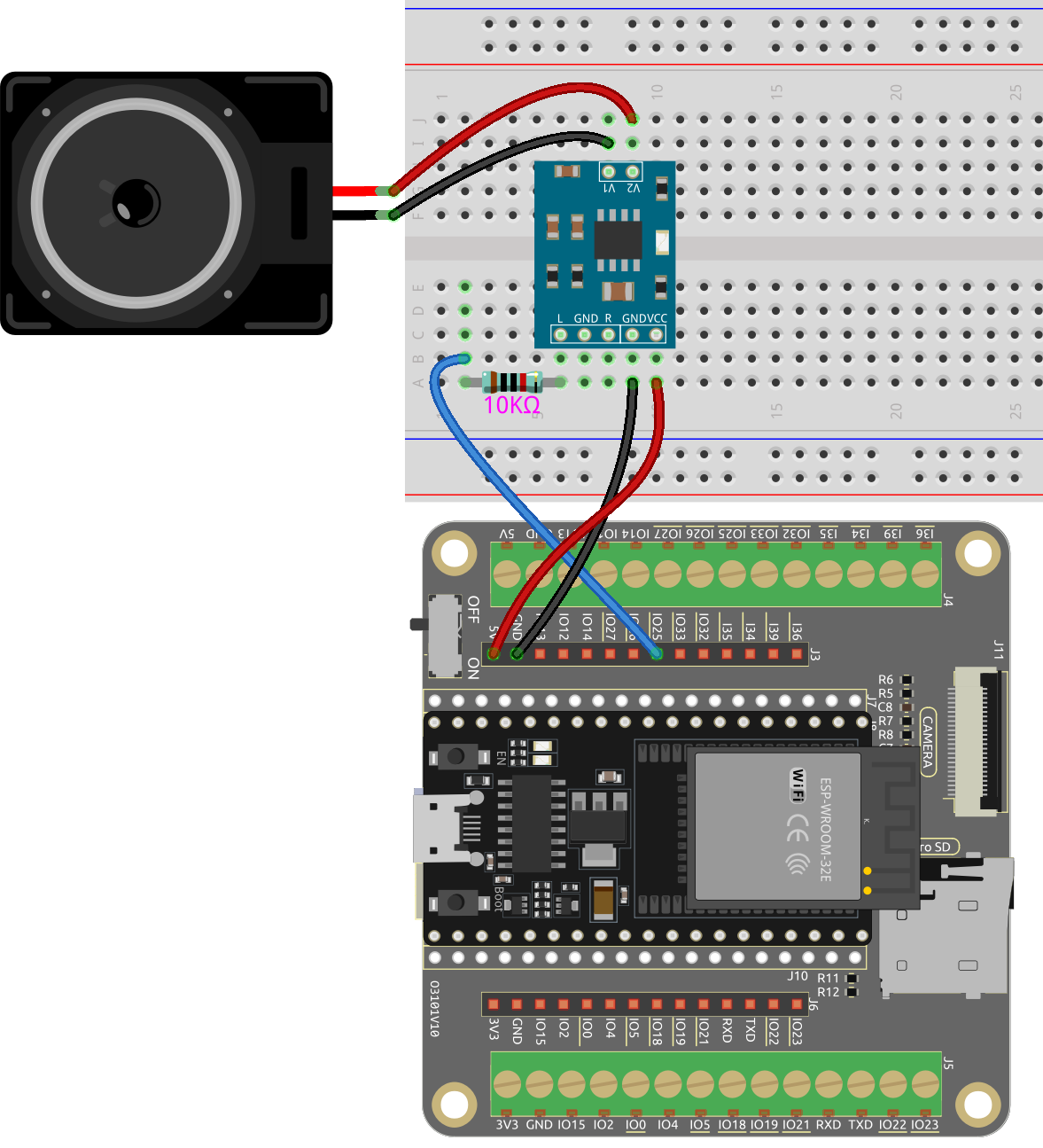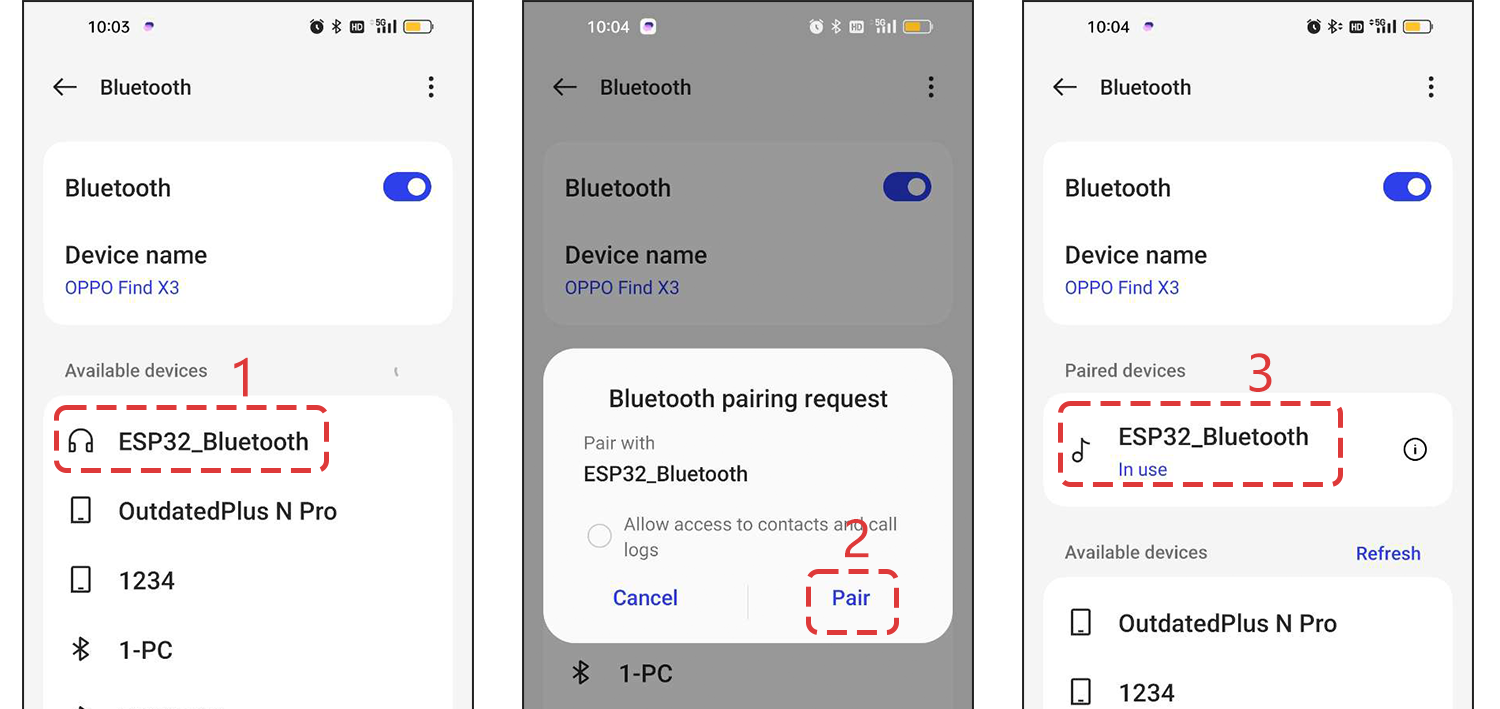7.3 Bluetooth Audio Player¶
The aim of the project is to provide a simple solution for playing audio from a Bluetooth-enabled device using the built-in DAC of the ESP32.
The project involves the use of the ESP32-A2DP library to receive audio data
from a Bluetooth-enabled device. The received audio data is then transmitted to the internal
DAC of the ESP32 using the I2S interface. The I2S interface is configured to operate in master mode,
transmit mode, and DAC built-in mode. The audio data is then played back through the speaker connected to the DAC.
When using the internal DAC of the ESP32, it is important to note that the output voltage level is limited to 1.1V. Therefore, it is recommended to use an external amplifier to boost the output voltage level to the desired level. It is also important to ensure that the audio data is in the correct format and sample rate to prevent distortion or noise during playback.
Required Components
In this project, we need the following components.
It’s definitely convenient to buy a whole kit, here’s the link:
Name |
ITEMS IN THIS KIT |
LINK |
|---|---|---|
ESP32 Starter Kit |
320+ |
You can also buy them separately from the links below.
COMPONENT INTRODUCTION |
PURCHASE LINK |
|---|---|
- |
|
- |
Operating Steps
Build the circuit.
As this is a mono amplifier, you can connect IO25 to the L or R pin of the audio amplifier module.
The 10K resistor is used to reduce high-frequency noise and lower the audio volume. It forms an RC low-pass filter with the parasitic capacitance of the DAC and audio amplifier. This filter decreases the amplitude of high-frequency signals, effectively reducing high-frequency noise. So, adding the 10K resistor makes the music sound softer and eliminates unwanted high-frequency noise.
If your SD card’s music is already soft, you can remove or replace the resistor with a smaller value.

Open the code.
Open the
7.3_bluetooth_audio_player.inofile under the path ofesp32-starter-kit-main\c\codes\7.3_bluetooth_audio_player.After selecting the board (ESP32 Dev Module) and the appropriate port, click the Upload button.
The
ESP32-A2DPlibrary is used here, refer to Manual Installation for a tutorial to install.
After selecting the correct board and port, click on the Upload button.
Once the code is uploaded successfully, turn on the Bluetooth-enabled device and search for available devices, then connect to the
ESP32_Bluetooth.
Play audio on the device and the audio should be played through the speaker connected to the ESP32.
Code Explanation
The code starts by including the
BluetoothA2DPSink.hlibrary, which is used to receive audio data from the Bluetooth-enabled device. TheBluetoothA2DPSinkobject is then created and configured with the I2S interface settings.#include "BluetoothA2DPSink.h" BluetoothA2DPSink a2dp_sink;
In the setup function, the code initializes an
i2s_config_t structwith the desired configuration for the I2S (Inter-IC Sound) interface.void setup() { const i2s_config_t i2s_config = { .mode = (i2s_mode_t) (I2S_MODE_MASTER | I2S_MODE_TX | I2S_MODE_DAC_BUILT_IN), .sample_rate = 44100, // corrected by info from bluetooth .bits_per_sample = (i2s_bits_per_sample_t) 16, // the DAC module will only take the 8bits from MSB .channel_format = I2S_CHANNEL_FMT_RIGHT_LEFT, .communication_format = (i2s_comm_format_t)I2S_COMM_FORMAT_STAND_MSB, .intr_alloc_flags = 0, // default interrupt priority .dma_buf_count = 8, .dma_buf_len = 64, .use_apll = false }; a2dp_sink.set_i2s_config(i2s_config); a2dp_sink.start("ESP32_Bluetooth"); }
The I2S interface is used to transfer digital audio data between devices.
The configuration includes the
I2S mode,sample rate,bits per sample,channel format,communication format,interrupt allocation flags,DMA buffer count,DMA buffer length, and whether to use the APLL (Audio PLL) or not.The
i2s_config_t structis then passed as an argument to theset_i2s_configfunction of theBluetoothA2DPSinkobject to configure the I2S interface for audio playback.The
startfunction of theBluetoothA2DPSinkobject is called to start the Bluetooth audio sink and begin playing audio through the built-in DAC.